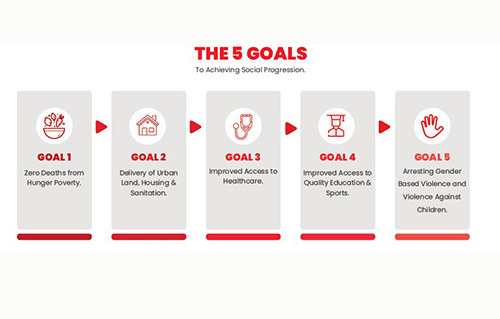The Harambee Prosperity Plan II (HPP II) covers 2021 to 2025 and builds on the solid foundation of the inaugural HPP 2016-2020. It continues to prioritise the implementation of targeted policy programmes to enhance service delivery, contribute to economic recovery and engender inclusive growth.
HPPII aims to ensure Namibia is poised to respond to domestic socio-economic challenges and global opportunities during and after the Covid-19 pandemic.
The formulation of HPPII involved a process of extensive literature review, workshops with subject matter experts and countrywide stakeholder consultations, including the 2019 Town Hall Meetings. The baseline for these consultations was the HPP Final Report (2016-2020) and contemporary developmental issues.
The HPPII remains a targeted Impact Plan, consisting of prioritised short to medium term goals and strategic actions to accelerate national development towards Vision 2030 and Prosperity for All.
The HPPII retains the five pillars, namely:
Pillar 1: Effective Governance
Pillar 2: Economic Advancement
Pillar 3: Social Progression
Pillar 4: Infrastructure Development
Pillar 5: International Relations and Cooperation
The HPP Pillars remain firmly anchored on the construct of an inclusive Namibian House, built on the solid foundation of peace, stability and the rule of law.
Pillar 3: Social Progression
The Social Progression Pillar takes a people-centred approach to development that aims to ensure improved quality of life for all Namibians, especially the most vulnerable members of our society. Meaningful progress in arresting poverty, income and wealth inequalities has been made. However, these gains risk being reversed by a number of intervening independent variables. The Desired Outcome for this Pillar is to provide the basic amenities for dignified life, social mobility and human development. This outcome will be achieved through five goals and 19 activities.
These five goals are arresting hunger poverty; urban land, housing and sanitation delivery; improved access to healthcare, and improved access to quality education and sports.
HPPII will redouble efforts to strengthen the foundations of the Namibian House by ensuring a dignified standard of living and continued access to health services and education, with a strong foundation in the early years. Moreover, the Covid-19 pandemic has revealed the need to intensify investments into specific areas and to reprioritise and elevate emerging priorities, such as gender-based violence and violence against children and e-learning.
The implementation of social progression programmes under HPPI achieved a 90% performance rating, with nine out of ten desired outcomes achieved. No Namibian was reported to have died from hunger during HPPI, despite the country enduring one of the worst droughts in recent history.
This is attributable to the extensive drought relief programme and Food Bank initiative rolled out in the peri-urban and rural areas of the country. The Food Bank assisted the most vulnerable households, while rural agricultural extension services intended to secure household food security for subsistence farmers.
The set targets for new residential erven and new housing units were achieved by 89% and 82%, respectively. The use of the bucket toilet system has been significantly reduced by 74% countrywide.
Infant and maternal mortality and morbidity declined substantially during the period. The number of TVET trainees exceeded the set target of 16 000 intakes by 99.8% to 34 920, while the quality of training and data collection also improved.
GOAL 1 – Zero deaths recorded as a result of hunger:
Securing household food security
Consolidation of social grants and the Food Bank
Regularise status of specified categories of undocumented & stateless persons
GOAL 2 – Delivery of urban land, housing and sanitation
Urban land delivery
Informal settlement upgrading
National housing delivery
Sanitation & bulk infrastructure
GOAL 3 – Improved access to public healthcare
Improve & increase public health infrastructure
Modernise central medical store (CMS)
Enhance access to treatment facilities for non-communicable diseases
Improved nutrition
Universal healthcare coverage
GOAL 4 - Improved quality of public education and sports
Improve & expand education infrastructure and physical facilities
Integrated early childhood development
Improve quality of education
Professionalisation of sports
GOAL 5 – Arresting gender based violence & violence against children
Provide empathetic, inclusive and correct care to GBV and VAC survivors at first contact
Strengthen procedures and infrastructure for better service to survivors
Strengthening safety nets


